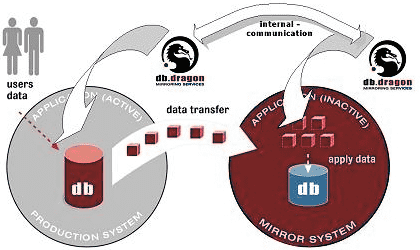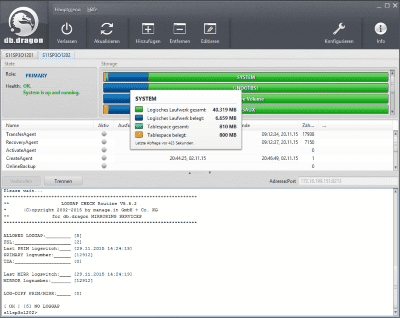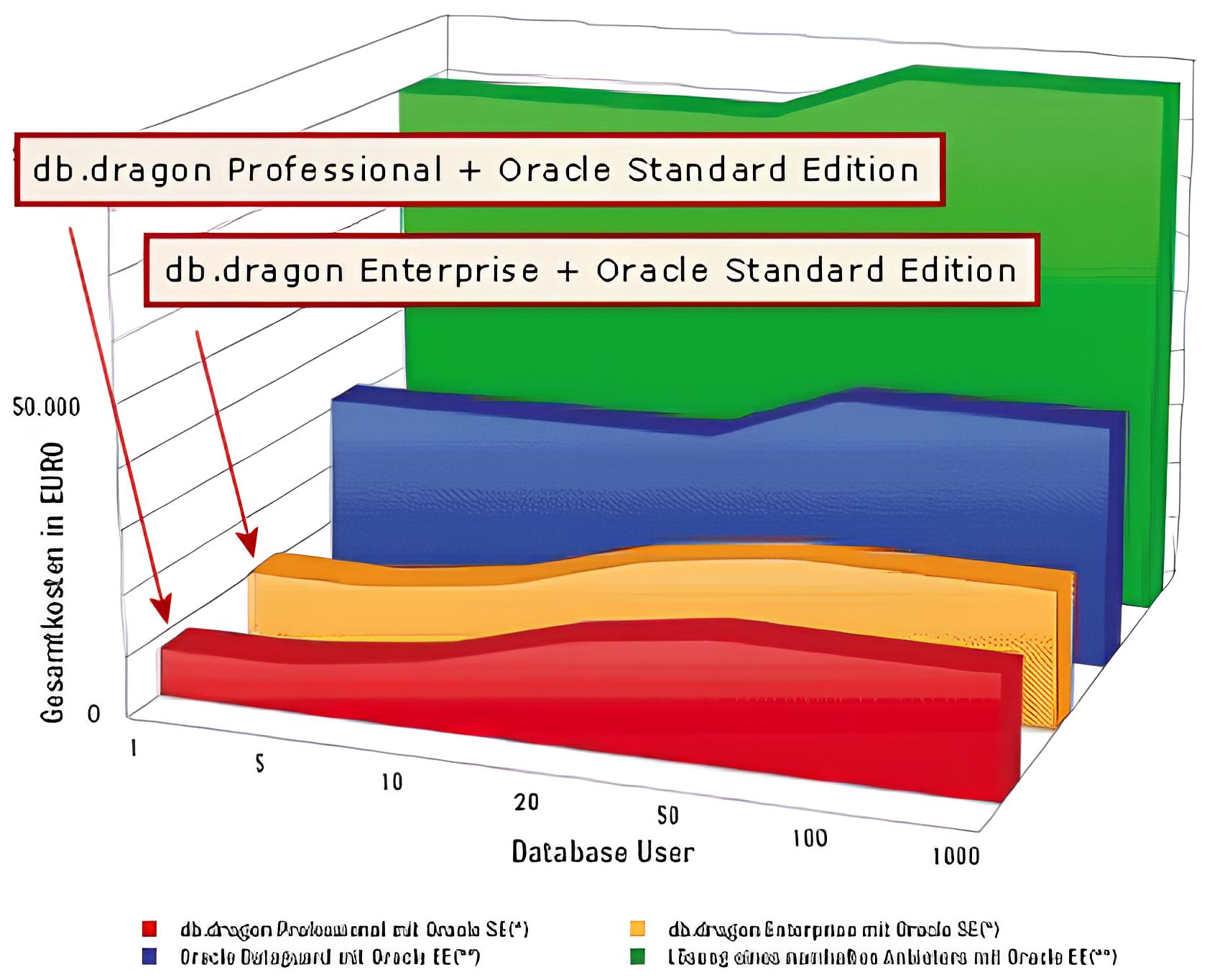High availability without comparison
How important a functioning database is for a company becomes apparent when an error or crash paralyzes the system. Then suddenly the production lines come to a standstill, orders cannot be processed, goods cannot be shipped, etc. Possible consequences: losses that run into the hundreds of thousands – or even cost the company’s existence. db.dragon protects you from such tragedies. Because this concept ensures the highest availability of your data. But that’s not all: with db.dragon you benefit for the first time from a solution that combines high availability, operating system independence and low acquisition costs.
It’s no wonder that it is used across Europe in a wide variety of companies and industries – and enjoys an excellent reputation in the automotive industry, for example.
With db.dragon, users can increase the performance of their productive system by outsourcing computationally intensive tasks such as queries or backups to the MIRROR database. This significantly increases the ROI of the high availability system, as it is used both for disaster recovery and also contributes to increasing the performance of the productive system.
How it works

| db.dragon allows you to synchronize two independent Oracle databases. One of the systems follows the other after a freely selectable time interval. This means: All changes to content or data structure are transferred from the primary to the secondary system, the “mirror”, with a time delay. If an error occurs, db.dragon reports this via email or SMS. Now the administrator can intervene: The mirror system becomes the primary system – and your data is immediately available again. The faulty system can be restored. |
The most important advantages at a glance
Protection against total failure of the database Additional data security through redundancy Possibility of location-independent connection via LAN/WAN Operating system-independent, resource-saving Java solution Can be installed during productive operation Simple, central administration Tests and evaluations on the mirror system are also possible Extremely cost-effective – Oracle Enterprise Edition not necessary Integration of your application through IP switching, like a clusterWAN connection with the WAN Accelerator Module
Easy integration and operation
Operating system independent management
| db.dragon can be installed while the primary system is running; The data is therefore available at any time. The installation and configuration phase can be used to familiarize administrators with the system. The operation itself is simple. In-depth Oracle knowledge is not required. |
| Comprehensive service: In addition to installation and configuration, we also carry out regular emergency drills for your employees upon request. This ensures that if the worst comes to the worst, the right thing is done automatically and that every move is correct. |

Modules and versions
| Features | Professional Edition | Enterprise Edition |
|---|---|---|
| Mirroring Module | ||
| Online Backup Module | ||
| Archive Cleaning Module | ||
| Service / Daemon Integration | ||
| Remote Console Module | ||
| Remote Console Module GUI | ||
| Oracle Tracefile Archive Module | ||
| Safe Mirroring Module | ||
| E-Mail Messaging Module | ||
| SNMP Integration | ||
| Mirror Backup Module | ||
| File synchronization via Simple File Synchronization Module | ||
| File synchronization via Extended File Synchronization Module (UNC path support) | ||
| Maintenance Switch Module | ||
| Time Delay Apply Module | ||
| Auto Structure Apply Module | ||
| Read Only Usage | ||
| Pre Error Detection Module | ||
| Application Switch Module | ||
| TestDB module with additional license key | ||
| WAN acceleration module with additional license key | ||
| Auto Network Failure Reconnect Module | ||
| Auto LogGap Detection Module (ALGD) |
The modules and their features
| Archive Cleaning Module (ACM): |
| Because the number of archives -Files continuously grows and the available storage space is usually limited, the available space must be constantly monitored. The AC module therefore includes an agent that always keeps the number of archive files constant. The administrator does not need to check. |
| Safe Mirroring Module (SMM): |
| Safe Mirroring Module (SMM): Continuous monitoring of the function of both agents ensures the secure mirroring service. The failure of the mirroring agent/system also results in an alarm message. This ensures the availability of both systems at all times. |
| E-Mail Messaging Module (EMM): |
| Errors that occur and necessary information about the system status is forwarded via email. Pagers and SMS can also be addressed with appropriate gateways. The recipients and the periodicity are freely configurable. A mail fallback server and SMTP-AUTH are supported. Emails can be sent either as standard text or HTML encoded. By defining error classes, different people can be notified of corresponding errors. |
| Maintenance Switch Module (MSM): |
| For maintenance work and emergency exercises, a maintenance switch can be carried out. The mirror database is activated without data loss and the primary database is used as a mirror. The switch can be done in both directions and is therefore ideal for maintenance work on the respective system. |
| Time Delay Apply Module (TDAM): |
| This module allows you to set any time delay between the mirror and the primary/productive system. The data on the mirror is therefore transmitted with a time delay. Logical errors, e.g. caused by faulty programs, can be avoided. The time factor can be set variably and consciously increased, for example when switching to a new operating system version. Of course, the time delay can also be deactivated. |
| Auto Structure Apply Module (ASAM): |
| This module transfers database structure changes that were made in the productive system are automatically transferred to the mirror (e.g. if another tablespace was added). The mirror system adopts these changes, updates the structure, and continues to run without functional restrictions. |
| Pre Error Detecting Module (PEDM): |
| By continuously monitoring the productive database, “major” database errors can be discovered: errors that were triggered either by the database itself or by an application. Accordingly, they are not transferred to the mirror. |
| Simple/Extended File Synchronization Module (S/EFSM): |
| Besides Due to the mirroring function of the database, many systems also require file synchronization. The S/EFS module allows you to synchronize files and/or directories from the productive system with the mirror system. A system-independent synchronization is supported. |
| Auto Network Failure Reconnect Module (ANFR): |
| Temporarily occurring network problems are detected and after the connection is restored Operation continues fully automatically! |
| Online backup module module (OB/MB): |
| In addition to pure database synchronization, The system requirement may also require a backup. This is provided by the OnlineBackup/MirrorBackup modules. In general, an online backup is carried out while the database is running. The data can be written to a local drive or a UNC path. In contrast to OnlineBackup, MirrorBackup runs on the Mirror Host. This eliminates any system load on the productive system. With the MirrorBackup, as with the OnlineBackup, a system restore (recovery) of the productive database can be carried out. In combination with the ArchiveCleaner module, every system restore requirement (backup cycles/generations) can be implemented Realize combination with a backup tape medium. In contrast to a pure tape backup, this procedure enables faster recovery because the first generation is written directly to a hard disk medium. |
| Read Only Module Module (ROM) : |
| To create time-critical reports and not put a strain on the productive database, the mirror database can be set to read-only mode (RO). During this time, the MIRROR is open for read operations – the resulting archive files continue to be transferred from the PRIMARY. This ensures that no data loss occurs. After RO mode has ended, all changes made will be applied to the mirror. Execution can be activated and deactivated time-controlled via the integrated scheduler. In this way, necessary reports (inventory reports!!) can be created, for example overnight, without user intervention being necessary. |
| Auto LogGap Detection Module (ALGD) |
| Depending on the system load on the productive system, the network transmission from the PRIMARY to the MIRROR host may be interrupted during operation. A so-called log gap can occur – the difference between the current log file of the PRIMARY and that of the MIRROR. db.dragon automatically recognizes this LogGap and immediately notifies the administrator. The maximum allowable offset between the PRIMARY and MIRROR host can be configured, allowing adaptation to different system environments. |
Cost Comparison
| An extremely low price – common systems either do not offer real high availability – or are very expensive. Different db.dragon. This solution combines high data availability with low acquisition costs. The reason: The Oracle Standard Edition is sufficient for use; it is not necessary to purchase the Oracle Enterprise Edition. db.dragon means for you: data security at a price that is significantly lower than comparable concepts. |
Another plus: db.dragon is licensed for the entire system. This means that only one license is necessary for two physical systems.

Do you have any questions?
Do not hesitate to contact us.